Greenhouse farming is an emerging trend in agriculture that has many benefits, including higher yields ad reduced environmental impact. It is a type of agriculture that uses artificial light to simulate direct sunlight and help plants grow faster. This technique can be used in various climates, including South Africa, where it has been increasingly adopted due to the region’s hot, dry conditions.
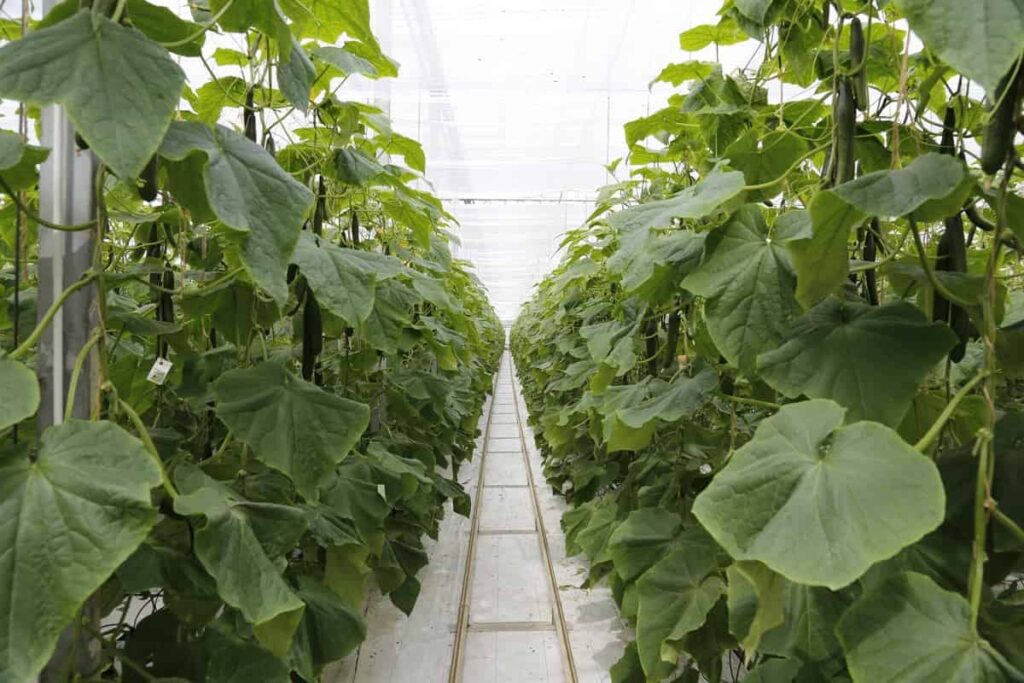
In this article, we explain the advantages of greenhouse farming in South Africa and what you need to know if you want to start using this technique on your farm. With a big enough space, anyone can install a greenhouse in South Africa and grow their plants all year round.
Greenhouse farming in South Africa
What is greenhouse farming?
It is a type of agriculture that uses controlled environments to produce crops. These environments are often called greenhouses because the glass walls allow sunlight in but keep the interior warm, allowing for year-round cultivation. The practice has grown in popularity recently because it enables farmers to produce crops indoors without the need for cold weather or outdoor irrigation.
Greenhouses also create an environment much more controlled than nature, allowing farmers to manage their crops better and harvest them at the most optimal time. As a result, this technology has increased the production of many fruits and vegetables in South Africa and other countries worldwide that have adopted it.
Benefits of greenhouse farming in the USA
- One of the benefits of greenhouse farming is that it allows farmers to grow crops year-round, even if it is winter outside. This means that they can get a wider variety of crops than they would be able to get if they only had access to seasonal climates. It also means they don’t have to worry about harsh weather conditions affecting their plants.
- Another advantage of greenhouse farming is that it produces less waste than traditional agriculture. This is because greenhouse plants are grown in containers instead of on the ground, and their growth does not require as much space as conventional crops.
- Greenhouse growers can grow a wide variety of crops using artificial lighting, which results in larger and more consistent yields than traditional agriculture. Another benefit of greenhouse agriculture is that it conserves energy. Greenhouses usually use less energy than traditional production methods, such as field planting or raising livestock indoors. This reduces emissions associated with transportation and manufacturing, two significant contributors to climate change.
- Greenhouse farming will enable farmers to control the environment inside the greenhouse, which leads to greater production efficiency and higher yields. In addition, greenhouse farming manure can be used as fertilizer on land outside the greenhouse, reducing pollution and improving soil health.
In case you missed it: Greenhouse Farming in the USA: How to Start, Cost, Crops, and States
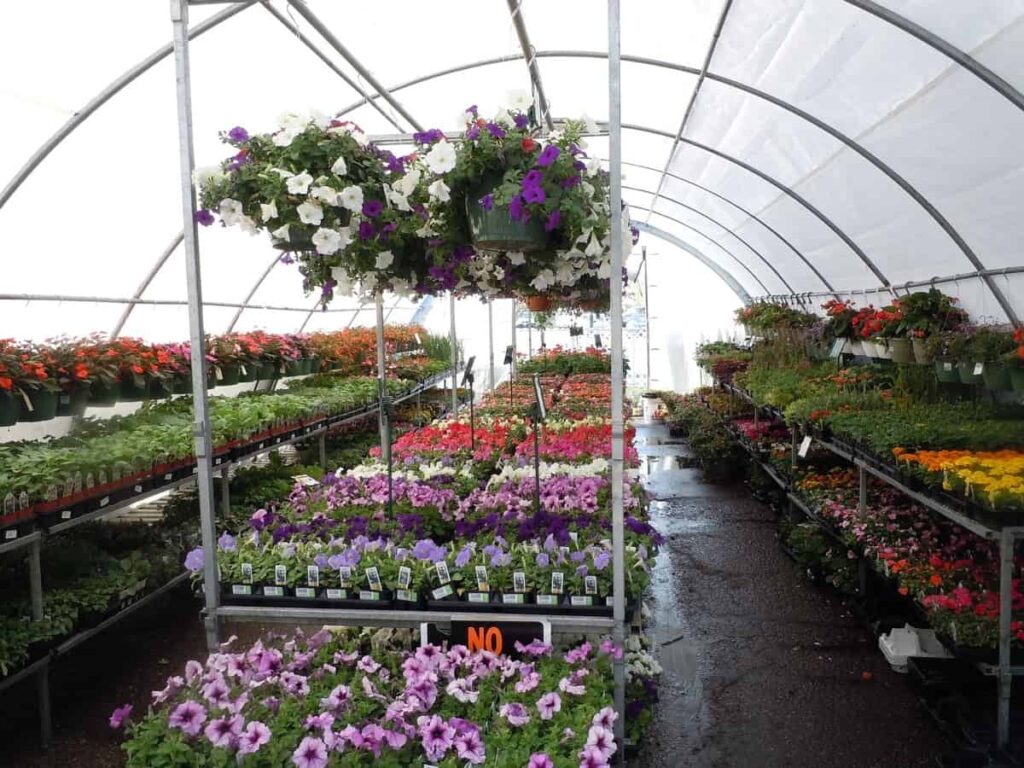
Greenhouse farming requirements in South Africa
- The climate in South Africa is perfect for greenhouse farming, with average temperatures ranging from 18 to 25°C and rainfall of around 700 mm per year. However, the essential requirement for greenhouse farming in South Africa is the availability of sunlight. The country’s South-easterly location means it receives a good amount of sun, making it an ideal place to grow vegetables and fruits. Additionally, South Africa has a moderate climate so crops can be grown year-round without much difficulty.
- Greenhouse farming conditions in South Africa vary depending on the region. In the north, greenhouse growers must contend with heat and humidity, while in the South, irrigation is a greater issue. The east coast has a moderating climate for growing plants such as tomatoes and cucumbers. The west coast has a dry environment that is not ideal for greenhouse production.
- A greenhouse should have an accurate temperature control system to ensure plants receive the right amount of sunlight, water, and nutrients. In addition, a ventilation system must be in place to prevent moisture build-up and pests from entering the greenhouse.
- There are some essential things that you will need to get started with greenhouse farming in South Africa: land, a greenhouse building, and the necessary equipment. You can find land for greenhouse farming in many places throughout the country, but the best locations will likely be in areas with good rainfall and warm temperatures.
- If you are starting a small farm, you may not need a large greenhouse. A smaller one will work well for growing vegetables, herbs, fruit trees, and flowers. However, you must invest in a good-quality greenhouse to grow larger crops such as fruits and vegetables.
Crops are grown under greenhouses in South Africa
- In South Africa, crops can be grown under greenhouses in many parts of the country. Greenhouses are an ideal way to grow crops in the area because they provide protection from the weather and allow for year-round cultivation. Most greenhouses are heated by natural gas or electric heating systems and have high-tech ventilation systems that ensure plants receive the proper amount of oxygen and sunlight.
- Greenhouse farming is a popular method of agriculture in South Africa because it allows farmers to cultivate crops indoors during winter when temperatures outside are below freezing. The downside to greenhouse farming is that it requires a lot of water, which must be given to plants through irrigation systems. However, greenhouse farming is generally more efficient than traditional farming methods, resulting in decreased environmental impact.
- The country has a wide variety of crops that can be grown in greenhouses, including Tomatoes, Strawberries, Cucumbers, Watermelons, Peppers, Eggplant, Zucchini, Beans, Peas, Melons, Lilies, Roses, and Squash. Greenhouse farmers can also grow flowers and plants that require warmer temperatures than those found outdoors.
- Tomatoes are popular because they are easy to grow and can be harvested early in the season when they are still small enough to eat without getting indigestion. Cucumbers are good for eating raw and are used in recipes such as pickles and salads. Peppers add flavor to many dishes, while beans provide protein and fiber. Melons are delicious, eaten fresh or preserved in syrup or dried out for later use. Lilies provide an attractive addition to any garden, while roses offer beautiful blooms throughout the year.
In case you missed it: 16 Key Rules for Effective Greenhouse Farm Management: From Planning to Reducing Production Cost
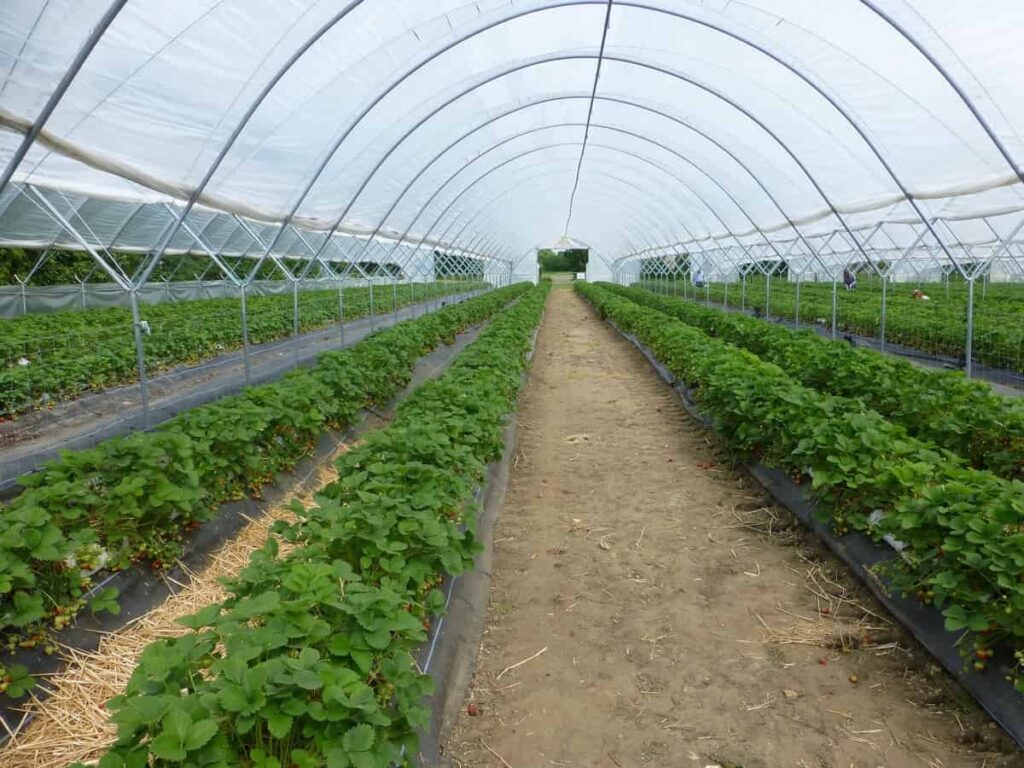
Greenhouse farming states in South Africa
- South Africa has been a leader in greenhouse farming for many years and has developed an extensive system that allows farmers to produce crops year-round in a controlled environment.
- South Africa is one of the top greenhouse-farming countries in the world. This is because the country has a temperate climate, fertile soil, and ample sunlight.
- Commercial grain-growing areas are predominantly located in the Western Cape province and the maize quadrangle (North West and Free State provinces). Subsistence farming mainly occurs in the North West and the Eastern Cape provinces.
- North-facing structures are ideal for getting the best sunlight without causing the greenhouse to overheat in the intense afternoon sun – especially in summer.
Fertilizing and watering for Greenhouse farming in South Africa
- Greenhouse farming in South Africa is a popular growing method for vegetables, fruits, and flowers. Many factors are necessary for choosing the right greenhouse for your farm, including the size of your space, the climate in which you live, and the specific crops you want to grow.
- To start greenhouse farming in South Africa, you’ll need to decide on your planting area and calculate how much water and fertilizer you’ll need. You may also want to invest in irrigation equipment or a rainwater harvesting system to help ensure good crop production.
What is the most profitable greenhouse farming in South Africa?
Greenhouse farming is a type of agriculture that uses large, enclosed structures to grow plants. In South Africa, greenhouse farming is the most profitable type of agriculture. This is because South Africa has a temperate climate, meaning the country has a long growing season. This makes it possible to grow crops such as tomatoes, cucumbers, and peppers in greenhouses. Greenhouse farming can be very profitable because it requires minimal inputs (compared to other types of agriculture), so there is little competition from other farmers.
Additionally, greenhouse farming produces high-quality products that can withstand temperatures outside the normal range. This makes it a good choice for producers who want to sell their products regionally or internationally. Greenhouses produce various crops, including vegetables, fruit trees, flowers, and ornamental plants. Greenhouse farming techniques have been developed over the years better to suit the conditions in different parts of the world. As a result, greenhouse farming is often called “warm-season agriculture.”
In case you missed it: How to Water Your Garden with Solar Power: For Home Gardening, Greenhouse, Polyhouse, and Outdoor
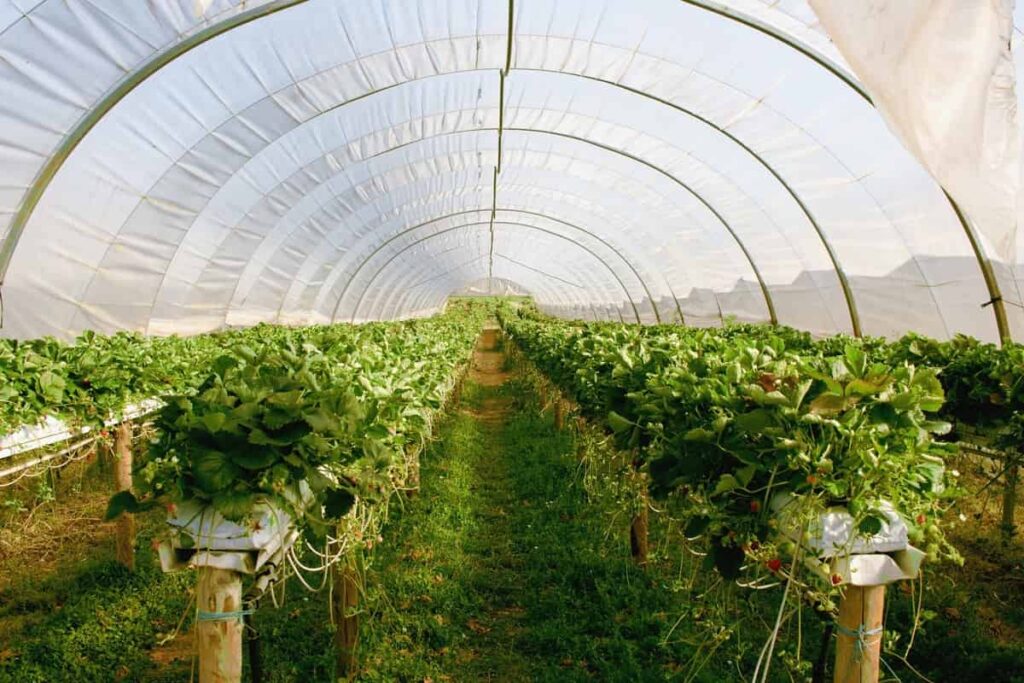
This means crops are grown during the warm months (January through March or June through September) when the weather is most favorable for growth. Greenhouse farming can be done using fixed or movable panels. Fixed panels use clear plastic or glass windows that can be opened or closed to control temperature and light exposure. They are less expensive than movable panels but require more maintenance because they need to be kept clean.
Different types of greenhouse farms in South Africa
- Lean-to type greenhouse
- Even Span Type Greenhouse
- Uneven Span Type Greenhouse
1. Lean-to-type greenhouses are the simplest and most traditional types of greenhouses. These greenhouses are made up of tubes, each about 3 feet high and 2.5 feet wide, connected by bent sections at the top and bottom. The tubes are covered with plastic or glass, each filling with warm air inside the house. A layer of soil is spread over the tubes, and young plants, bought or grown locally, are placed on top. The warm air and moist environment encourage the plants to grow rapidly, and they can be harvested within a few weeks
2. Even span-type greenhouses offer more flexibility than lean-to-type greenhouses. They consist of several long rows or panels, instead of individual tubes, between which warm air circulates freely. This allows them to be larger (up to 30 feet wide), more comfortable for the gardener (with space for several rows of plants), and better able to cope with fluctuations in temperature (due to wind or weather conditions).
3. Uneven span-type greenhouses are similar to even span-type greenhouses except that their panels are not evenly spaced along the length of the greenhouse. This arrangement gives the greenhouse a more natural appearance (as if it were built out of wooden boards) and makes it easier to control.
How many greenhouse farms are in South Africa?
There are currently over 100 greenhouse farms in South Africa, which are growing rapidly. Greenhouse farming is a relatively new technology in South Africa and is growing in popularity due to its high yields and environmental benefits. Greenhouse farms use artificial light to simulate the sun’s warmth, allowing farmers toproducew a wide range of crops, including fruits, vegetables, flowers, and herbs indoors.
In case you missed it: Top 22 Succulents to Grow at Home: in Pots, Indoors, Greenhouse, Problems, and Care
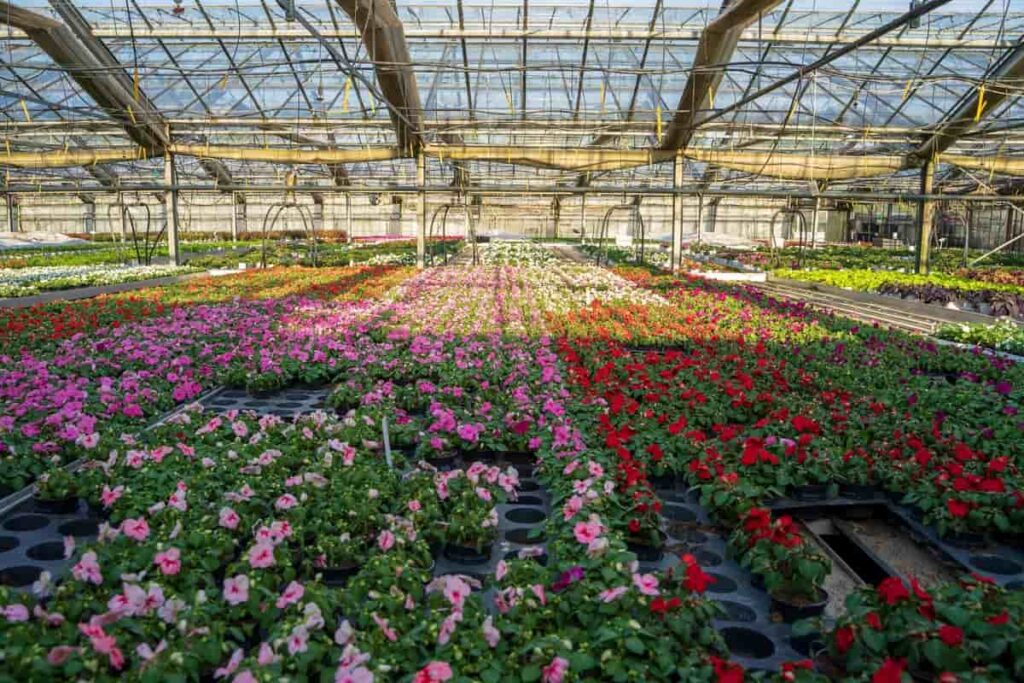
The benefits of greenhouse farming include reduced energy costs, increased food security, and lower emissions. The main challenge faced by greenhouse farmers is maintaining a consistent temperature throughout the year. Many greenhouse farms use thermal insulation or heating systems powered by renewable energy sources such as solar or wind to overcome this obstacle.
Greenhouse subsidy in South Africa
The South African government is subsidizing greenhouse farming to increase the production of crops for export. The subsidy was designed to help the agricultural sector recover from a decade of a deep recession. The subsidy program provides a payment of around R1,000 per hectare (2.5 acres) of land devoted to greenhouse farming, which is significantly higher than market rates.
The subsidy has helped stimulate greenhouse farming in the Southern African country. Greenhouse growers can obtain subsidies for their crops even if they do not sell their products domestically. The government also supports research and development into new greenhouse technologies. This support is intended to help greenhouses become more efficient and cost-effective, benefiting the agriculture sector.
Critics of the subsidy argue that it does not address the underlying issues that caused the decline in agricultural production in South Africa in the first place. In addition, they say that the program does little to promote innovation or improve efficiency within the agricultural sector, instead relying on existing players to maintain their monopoly on production.
Greenhouse farming challenges in South Africa
South Africa has a temperate climate with high levels of rainfall, which is perfect for greenhouse farming. However, the weather can be volatile, and extreme weather conditions can cause crop damage. Greenhouse farming is also sensitive to pests and diseases. Therefore, greenhouses must have good infrastructure to overcome these challenges, including proper ventilation and heating systems.
Two main types of commercial greenhouses in South Africa
Commercial greenhouse farming in South Africa began in the 1990s, as the country took advantage of unutilized land and climatic benefits to increase food production. Commercial greenhouse farming in South Africa is divided into two main types: cold storage, or “cool season,” and warm storage, or “hot season” cultivation.
1. The cool season crops are typically vegetables, fruits, flowers, and ornamental plants that can be stored at temperatures between 4°C and 18°C for up to six months. These crops include Bell Peppers, Cucumbers, Kiwi Fruit, Tomatoes, Sweet Corn, Strawberries, and Apples.
2. The hot season crops are typically Maize, Sunflowers, Cotton, Sugarcane, and Soya Beans that require warmer temperatures of 25°C to 30°C for growth. Other crops cultivated using greenhouses during hot or cold seasons include Avocados, Grapefruit, Lemons, and Limes.
The most important factor when choosing a crop to grow using a greenhouse is the preferred climate zone for that particular plant species. For example, tomatoes prefer warm weather, while bell peppers prefer cooler weather. Each crop type has specific requirements for temperature and humidity levels, which must be met for optimum growth.
In case you missed it: Growing Broccoli in Greenhouse – Planting, Farming
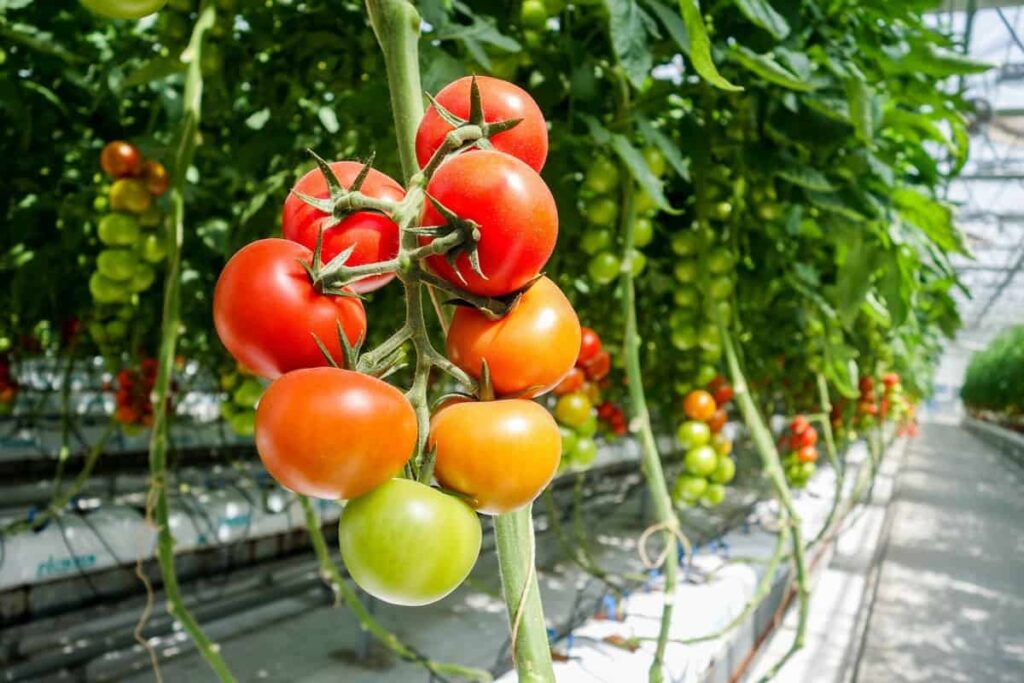
Steps to starting greenhouse farming in South Africa:
- Research the best greenhouse growing conditions for your type of plants
- Determine the size of your greenhouse and purchase or build the necessary components
- Select plants that will grow well in a greenhouse and forecast their seasonal needs
- Install lighting, fans, and insulation to create an optimum growing environment
- Monitor plant growth and make necessary adjustments to the environment based on results
- Water plants when needed using drip irrigation systems or mist spraying devices
- Fertilize plants appropriately with balanced fertilizers every two weeks during active growth and every week during rest periods
- Prune plants as needed to promote healthy growth and prevent disease
- Remove dead or diseased plants from the greenhouse periodically to maintain healthy growing conditions
- Take care of pests and diseases by using appropriate control methods
Vegetable greenhouse tunnels in South Africa
If you aren’t looking to install a fully-fledged greenhouse, you might consider putting up a vegetable tunnel to keep your produce safe and protected. Different vegetable tunnel suppliers offer different sizes and different variations.
One of the most important aspects of greenhouse farming is having good vegetable tunnels. These can be made from any sturdy material, but PVC or plastic are usually the best because they are lightweight and easy to work with. One of the biggest advantages of using greenhouses is that they provide year-round yields, no matter what the weather is like outside.
Conclusion
Greenhouse farming has become increasingly popular, not just because it’s environmentally friendly but also because it allows for more efficient food production. Greenhouse farming has become a popular method of Agriculturally in recent years due to the benefits it offers.
It is also growing in popularity because South Africa has some of the best climatic conditions for greenhouse farming. Greenhouse farming has many advantages, including improved soil quality, pest control, and crop yields.
- Types of Pesticides Used in Agriculture: A Beginner’s Guide
- Economical Aquaculture: A Guide to Low-Budget Fish Farming
- 15 Common Planting Errors That Can Doom Your Fruit Trees
- How to Make Houseplants Bushy: Effective Tips and Ideas
- Innovative Strategies for Boosting Coconut Pollination and Yield
- Pollination Strategies for Maximum Pumpkin Yield
- The Complete Guide to Chicken Fattening: Strategies for Maximum Growth
- Natural Solutions for Tulip Problems: 100% Effective Remedies for Leaf and Bulb-Related Issues
- Revolutionizing Citrus Preservation: Towards a Healthier, Greener Future
- Natural Solutions for Peony Leaf and Flower Problems: 100% Effective Remedies
- Maximizing Profits with Avocado Contract Farming in India: A Comprehensive Guide
- Natural Solutions for Hydrangea Problems: 100% Effective Remedies for Leaf and Flowers
- The Ultimate Guide to Choosing the Perfect Foliage Friend: Bringing Life Indoors
- From Sunlight to Sustainability: 15 Ways to Use Solar Technology in Agriculture
- The Ultimate Guide to Dong Tao Chicken: Exploring from History to Raising
- The Eco-Friendly Makeover: How to Convert Your Unused Swimming Pool into a Fish Pond
- Mastering the Art of Delaware Chicken Farming: Essentials for Healthy Backyard Flocks
- 20 Best Homemade Fertilizers for Money Plant: DIY Recipes and Application Methods
- How to Craft a Comprehensive Free-Range Chicken Farming Business Plan
- Brighten Your Flock: Raising Easter Egger Chickens for Beauty and Bounty
- How to Optimize Your Poultry Egg Farm Business Plan with These Strategies
- Subsidy for Spirulina Cultivation: How Indian Government Schemes Encouraging Spirulina Farmers
- Ultimate Guide to Raising Dominique Chickens: Breeding, Feeding, Egg-Production, and Care
- Mastering the Art of Raising Jersey Giant Chickens: Care, Feeding, and More
- Ultimate Guide to Raising Legbar Chickens: Breeding, Farming Practices, Diet, Egg-Production
- How to Raise Welsummer Chickens: A Comprehensive Guide for Beginners
- How to Protect Indoor Plants in Winter: A Comprehensive Guide
- Ultimate Guide to Grow Bag Gardening: Tips, Tricks, and Planting Ideas for Urban Gardeners
- Guide to Lotus Cultivation: How to Propagate, Plant, Grow, Care, Cost, and Profit
- Agriculture Drone Subsidy Scheme: Government Kisan Subsidy, License, and How to Apply Online
- Ultimate Guide to Raising Araucana Chickens: Breed Profile, Farming Economics, Diet, and Care
- Bringing Hydroponics to Classroom: Importance, Benefits of Learning for School Students
- Ultimate Guide to Raising Polish Chickens: Breed Profile, Farming Economics, Diet, and Care
- Ultimate Guide to Raising Australorp Chickens: Profile, Farming Economics, Egg Production, Diet, and Care
- Silkie Chicken Farming: Raising Practices, Varieties, Egg Production, Diet, and Care
- Sussex Chicken Farming: Raising Practices, Varieties, Egg Production, Diet and Care